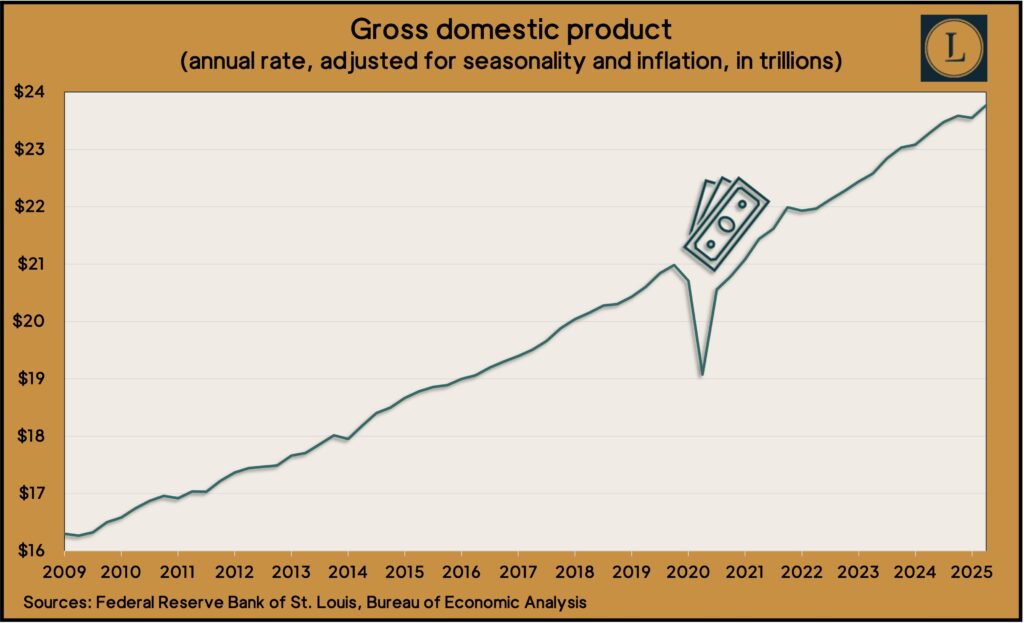Podcast: Play in new window | Download
Advisors on This Week’s Show
(with Max Hoelzl,engineered by Jason Scuglik)
Week in Review (Sept. 22-26, 2025)
Significant Economic Indicators & Reports
Monday
No major releases
Tuesday
No major releases
Wednesday
The seasonally adjusted annual rate of new home sales soared 20.5% in August. The Commerce Department reported the sales rate was up more than 15% from the year before. At a pace of 800,000 new houses a month, sales were at their highest level since January 2022, just before the Federal Reserve Board began a series of interest rate increases aimed at lowering decades-high inflation. The supply of new houses for sale dipped to its lowest level in more than two years. The median sales price was $413,500, up 1.9% from August 2024.
Thursday
The Commerce Department said orders for durable goods rose in August for the first time in three months. Demand for long-lasting manufactured products gained 2.9%, driven by orders for commercial aircraft. Excluding volatile costs for transportation goods, orders advanced 0.4%. Compared to August 2024, orders rose 1.7% overall and 1.9% excluding transportation. Core capital goods orders, a proxy for business investments, added 0.6% from July and were up 2.4% from the year before.
The U.S. economy grew at an annual pace of 3.8% in the second quarter of 2025, according to the final of three estimates of the gross domestic product. The Bureau of Economic Analysis revised the rate from 3.5% in the second estimated because of evidence of stronger consumer spending, which rose at a 2.5% annual pace, vs. 1.6% in the previous report. Overall, GDP rebounded from a decline of 0.6% in the first quarter, which was driven by a surge in imports leading up to increased U.S. tariffs on goods and services from other countries. The personal consumption expenditure index showed inflation rising 2.4% from the second quarter of 2024, thus continuing to outpace the 2% long-range target set by the Federal Reserve Board.

The four-week moving average for initial unemployment claims dipped for the second week in a row. The average was down 35% from its 58-year average, highlighting an ongoing reluctance by employers to let workers go. The Labor Department said nearly 1.8 million Americans were claiming unemployment compensation in the latest week, down 2.4% from the week before and up 5.7% from the same time last year.
Blaming elevated mortgage rates and low inventories, the National Association of Realtors reported a drop in existing home sales in August. The annual rate of 4 million houses sold was down 0.2% from July and up 1.8% from August 2024. Some 4.1 million sold in all of 2024, which was the lowest since 1995. The trade association said it expects decreasing mortgage rates and growing inventories to spur sales in coming months. It also noted the support of the wealth effect from higher equity in stocks and housing. The median sales price in August was $422,600, up 2% from the year before, the 26th consecutive month-to-month increase.
Friday
Accounting for about 70% of U.S. gross domestic product, consumer spending is a key economic indicator. In its monthly reports on personal income and outlays, the Bureau of Economic Analysis provides estimates on consumer spending as well as updates on the personal consumption expenditure index, the Federal Reserve Board’s preferred measure of inflation.
Another report, from the University of Michigan, uses surveys to measure consumer sentiment, which is considered an indication of future consumer spending. The sentiment index includes consumer opinions on current economic conditions as well as expectations for both the economy and personal finances.
Market Closings for the Week
- Nasdaq – 22484, down 147 points or 0.7%
- Standard & Poor’s 500 – 6644, down 21 points or 0.3%
- Dow Jones Industrial – 46247, down 68 points or 0.1%
- 10-year U.S. Treasury Note – 4.19%, up 0.05 point
